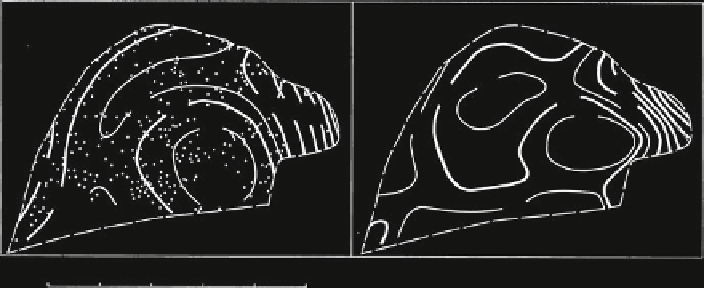Geoscience Reference
In-Depth Information
2.65
2.65
CUBIC SURFACE
QUINTIC SURFACE
SCALE OF MILES
0
1
2
3
4
5
Fig. 7.6 Cubic and quintic trend surfaces for specific gravity data, Mount Albert Peridotite
intrusion.
Dots
denote locations of specimens (Source: Agterberg
1974
, Fig. 45)
ESS
56.0 % for the quintic trend surface. Calculated values for the 3-D cubic along
the topographic surface are shown for the CD profile in Fig.
7.7e
. Because all
observation points lie in the topographic surface, the elevation
w
could be approxi-
mated by a 2-D polynomial in
u
and
v
. Consequently, a 3-D trend
f
(
u
,
v
,
w
)becomesa
2-D trend
g
(
u
,
v
)if
w
,ascontainedin
f
(
u
,
v
,
w
), is replaced by its polynomial in
u
and
v
. The reliability of the 3-D trend
f
(
u
,
v
,
w
) decreases rapidly outside the topographic
surface. Figure
7.7c, d
show extrapolations of the 3-D cubic trend in the vertical
direction obtained by setting w equal to 2,000 and 3,000 ft., respectively. This, of
course, results in two ordinary cubic trend surfaces for specific gravity.
The results shown in Fig.
7.7c, d
can be compared with the contour map for the
topographic surface (Fig.
7.7a
). The following interpretation is suggested. In Mount
Albert, specific gravity is, by approximation, linearly related to volume percentage
serpentine. Thus, a low value indicates a soft rock relatively sensitive to erosion. Two
of the three rivers originating onMount Albert follow zones of weakness at the 3,000-
ft. level rather than at the 2,000-ft. level (Fig.
7.7
). Further comparison with the
contour map for elevation suggests present-day topography was controlled by the
distribution of less weathering resistant rocks at higher levels. It can be concluded
that the pipe of maximum serpentinization moved northward as well as upward.
¼
7.1.3 Whalesback Copper Mine Example
The Whalesback copper deposit near Springdale, Newfoundland, provides an
example of 2-D and 3-D trend analysis in a situation that the values are
autocorrelated (Fig.
6.15a
) and have a frequency distribution that is positively
skewed with a long tail of large values. The orebody which has largely been
mined out consists of chloritic altered volcanics containing pyrite and chalcopyrite
mainly in disseminated form. However, these minerals also tend to cluster and form

Search WWH ::

Custom Search